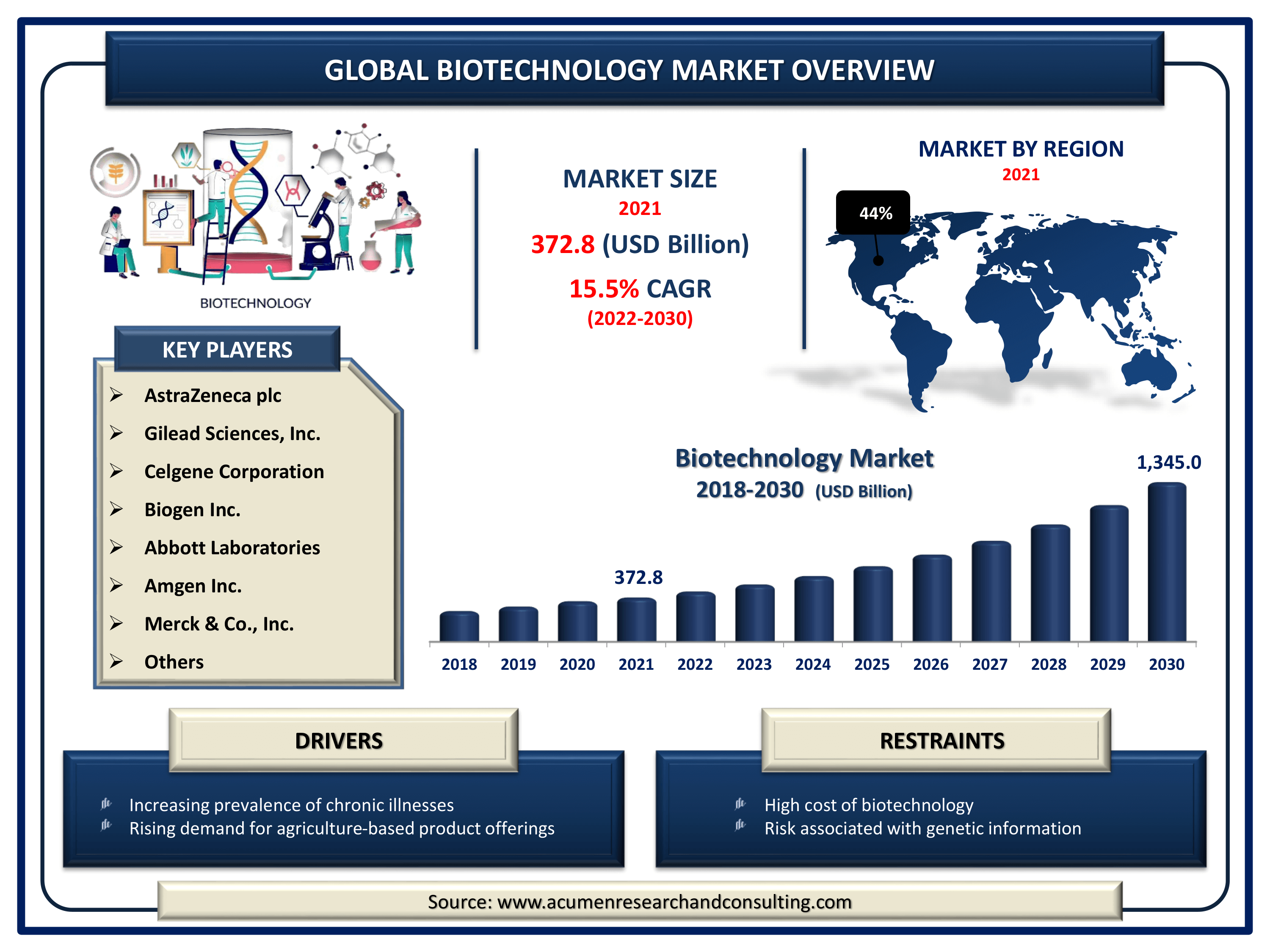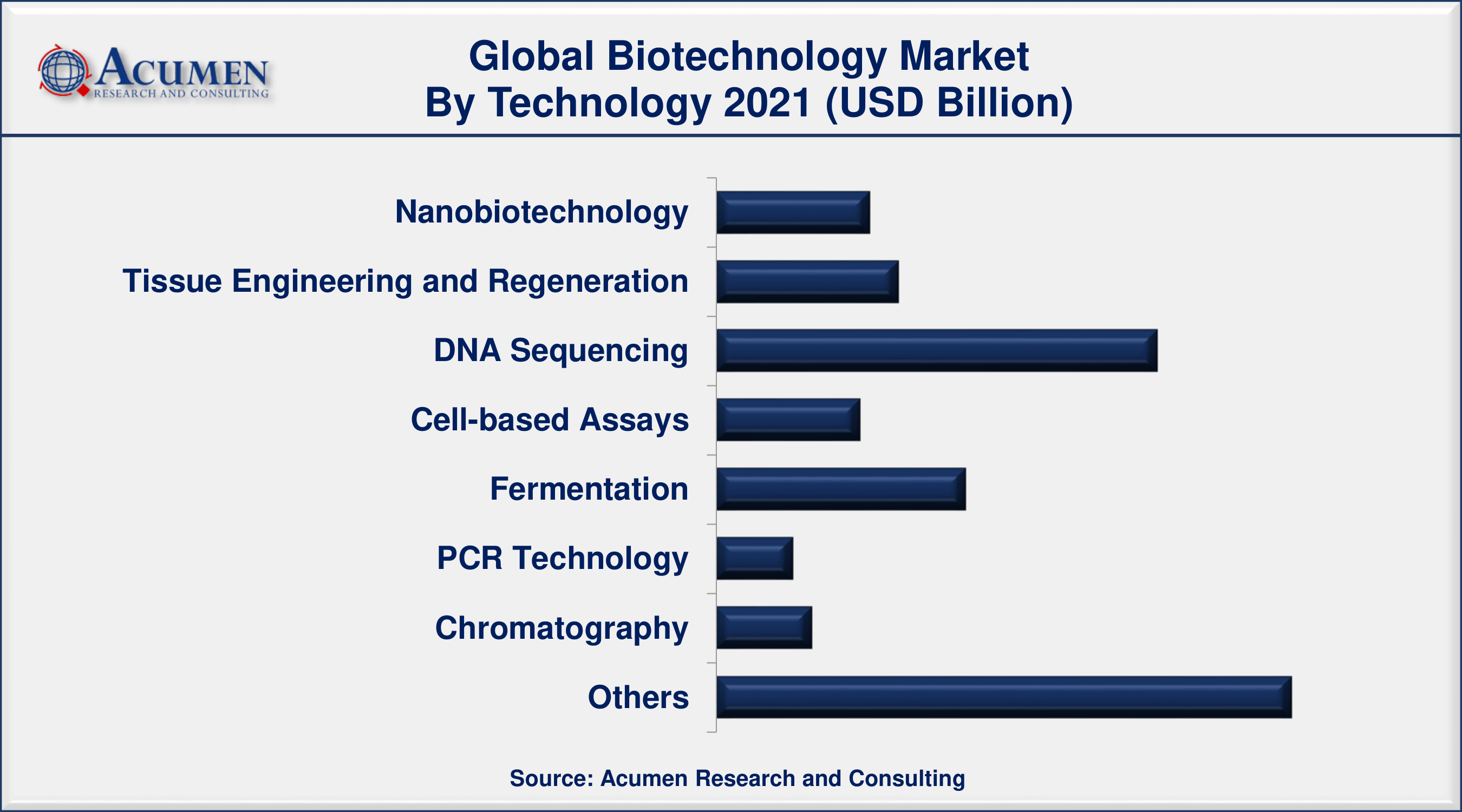May 2024
Biotechnology Market Size accounted for USD 372.8 Billion in 2021 and is estimated to achieve a market size of USD 1,345.0 Billion by 2030 growing at a CAGR of 15.5% from 2022 to 2030.
The Global Biotechnology Market Size accounted for USD 372.8 Billion in 2021 and is estimated to achieve a market size of USD 1,345.0 Billion by 2030 growing at a CAGR of 15.5% from 2022 to 2030. The rising prevalence of chronic illnesses is one of the primary factors expected to drive the biotechnology market growth. Also, the market is propelled by significant government support in the form of measures targeted at modernizing the regulatory framework, improving approval processes and reimbursement policies, and standardizing clinical research. The increasing adoption of organic food products necessitates the use of biotechnology in the agriculture sector, which will drive the biotechnology market revenue growth.

Biotechnology Market Report Key Highlights
Biotechnology is a broad category of technologies that use living organisms or parts of living organisms to create a variety of products. Biotechnology can be used to create drugs and therapeutics, nutritional compounds, environmentally friendly chemicals and materials, biofuels, and novel functional materials. More broadly, medical biotechnology, agricultural biotechnology and industrial biotechnology will all play increasingly important roles in our everyday life. To solve environmental problems, biotechnology can also be used to degrade toxic or harmful chemicals and agents. Biotechnology, like all technologies, has the potential to provide enormous benefits while also posing significant risks. Many global issues, such as climate change, an aging society, food security, energy security, and infectious diseases, to name a few, could be addressed with biotechnology.
Global Biotechnology Market Dynamics
Market Drivers
Market Restraints
Market Opportunities
Biotechnology Market Report Coverage
| Market | Biotechnology Market |
| Biotechnology Market Size 2021 | USD 372.8 Billion |
| Biotechnology Market Forecast 2030 | USD 1,345.0 Billion |
| Biotechnology Market CAGR During 2022 - 2030 | 15.5% |
| Biotechnology Market Analysis Period | 2018 - 2030 |
| Biotechnology Market Base Year | 2021 |
| Biotechnology Market Forecast Data | 2022 - 2030 |
| Segments Covered | By Technology, By Application, And By Geography |
| Regional Scope | North America, Europe, Asia Pacific, Latin America, and Middle East & Africa |
| Key Companies Profiled | AstraZeneca plc, Gilead Sciences, Inc., Celgene Corporation, Biogen Inc., Abbott Laboratories, Amgen Inc., Novo Nordisk A/S, Merck & Co., Inc., Johnson & Johnson Services, Inc., and Novartis AG. |
| Report Coverage |
Market Trends, Drivers, Restraints, Competitive Analysis, Player Profiling, Regulation Analysis |
Currently, What Are The Big Trends In Biotechnology?
According to a World Economic Forum (WEF) report, biotechnology is advancing at a rapid pace. There are numerous potential applications for genome editing in living organisms, including microorganisms, plants, and animals. With such advancements, humans could improve bio-based chemical production, increase food production while maintaining nutritional value, or manufacture organs for transplant. Metabolic engineering and synthetic biology are also advancing rapidly. As a result, instead of relying on fossil fuels, many chemicals, fuels, and materials are now made from renewable biomass. Furthermore, remarkable advancements are being made in healthcare and the medical sector. New, highly complex natural compounds derived from bio-sources are being developed for pharmaceutical applications. Stem-cell therapy, ICT-integrated biotechnology, and other innovations will aid in addressing the health challenges posed by an aging population.
But apart from that, biotechnology will advance significantly by 2030. Biotechnology could also aid in the resolution of large-scale national issues such as healthcare. Global healthcare spending is currently estimated to be around US$8 trillion. As a result, it is reasonable to expect biotechnology to become a part of people's daily lives by 2030, ranging from drugs, medicine, and therapeutics to environmentally friendly chemicals, fuels, and materials.
Big Calls For "Biotechnology" In Agriculture
The United States Department of Agriculture (USDA) supports the responsible and appropriate application of science and technology, including biotechnology, to address agricultural challenges and consumer needs. The USDA is critical in ensuring that biotechnology plants and products derived from these plants are safe to grow and use in the United States. USDA supports the introduction of these plants and products into commerce, as well as the introduction of these and other products into the global marketplace. Three federal agencies are involved in ensuring that biotechnology plants and the numerous products derived from them are safe for farmers to use, safe to consume as food or feed, and safe for the environment. These are the USDA's Animal and Plant Health Inspection Service, the Food and Drug Administration of the Department of Health and Human Services, and the United States Environmental Protection Agency. But apart from that, many of these new GE varieties have been quickly adopted by US farmers, so in 2012, 88% of corn, 94% of cotton, and 93% of soybeans planted in the US were genetically engineered varieties. The biotech also contributes significantly to the production of other crops such as alfalfa, papaya, and sugar beet. Furthermore, the United States is the world's largest exporter of agricultural products, which helps feed the world's population, and our export markets are critical to the health of farm communities across the country. Because the majority of the corn and soybeans we export are biotechnology-derived, it is critical that we collaborate with our trading partners to help them understand the technical aspects of new products and how we determined that they meet our high safety standards, to open up new markets, and to ensure that our products are treated fairly in the global marketplace.
Cell-Free Technologies Accelerate Industrial Biotechnology
Microbes, such as bacteria, are being used as miniature factories in industrial biotechnology. These factories would turn molecules, the smallest chemical packages, into desirable products. Scientists have created a cell-free framework that allows them to rapidly select from hundreds of enzyme pathways. To facilitate the design of microbial factories, the framework eliminates the need to use intact cells. Accelerating biotechnology research and development could have significant benefits for a variety of industries. Biotechnology has the potential to advance fields ranging from clean energy to consumer products. This new cell-free approach, for example, has already sped up the design of enzyme pathways to produce industrial chemicals in the microbe "Clostridium autoethanogenum”. This microbe is difficult to manipulate but extremely effective at consuming waste carbon in the environment. This framework is simple to implement and will reduce the number of microbes that must be engineered and tested. It also shortens the time required to achieve specific goals.
Biotechnology Market Segmentation
The worldwide biotechnology market segmentation is based on the technology, application, and geography.
Biotechnology Market By Technology

Biotechnology Market By Application

Biotechnology Market Regional Outlook
North America
Europe
Latin America
Asia-Pacific
The Middle East & Africa (MEA)
Asia-Pacific Region Is Expected To Dominate The Market
According to biotechnology industry analysis, the Asia-Pacific biotechnology market would grow at the fastest rate in the coming years. A large patient pool in densely populated countries such as India and China, which are prone to various diseases, will be a primary market driver for regional business growth. Furthermore, widespread biotechnology adoption in agriculture and industrial applications will eventually favor market progression. China is one of the prominent countries in the Asia-Pacific that is expected to have a reasonable share in the coming years. The rising prevalence of chronic diseases in the country is one of the major drivers of the global biotechnology market. Furthermore, China's focus on creating an innovation-friendly regulatory environment to address the shortage of essential drugs will be beneficial to market development. Various healthcare reforms in China, as well as investments in biotechnology, will accelerate the industry's growth.
Biotechnology Market Players
Some of the top biotechnology market companies offered in the professional report include AstraZeneca plc, Gilead Sciences, Inc., Celgene Corporation, Biogen Inc., Abbott Laboratories, Amgen Inc., Novo Nordisk A/S, Merck & Co., Inc., Johnson & Johnson Services, Inc., and Novartis AG.
Looking for discounts, bulk pricing, or custom solutions? Contact us today at sales@acumenresearchandconsulting.com
May 2024
December 2020
January 2020
November 2022